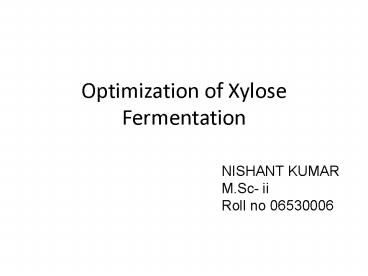Optimization of Xylose Fermentation - PowerPoint PPT Presentation
1 / 18
Title:
Optimization of Xylose Fermentation
Description:
Xylose or wood sugar, one of the most abundant carbohydrates in nature, is an ... control & promotor strength was validated by using lacZ expression & -Gal assay. ... – PowerPoint PPT presentation
Number of Views:230
Avg rating:3.0/5.0
Title: Optimization of Xylose Fermentation
1
Optimization of Xylose Fermentation
NISHANT KUMAR M.Sc- ii Roll no 06530006
2
INTRODUCTION
- Xylose or wood sugar, one of the most abundant
carbohydrates in nature, is an aldopentose a
monosaccharide containing five carbon atoms and
including an aldehyde functional group.
3
XYLOSE METABOLISM
4
Xylose Metabolism S. cerevisiae
- Native strains of S. cerevisiae do not assimilate
xylose. - In xylose fermenting yeasts, xylose is reduced to
xylitol by NADPH-linked xylose reductase (XR) and
xylitol is oxidized to xylulose by NAD-linked
xylitol dehydrogenase (XDH). Subsequently
xylulose is phosphorylated by xylulokinase (XK)
for assimilation via the pentose phosphate
pathway.
5
Xylose Metabolism S. cerevisiae
- The discovery that S. cerevisiae can ferment
xylulose initiated metabolic engineering of
xylose fermentation in S. cerevisiae. - Heterologous expression of genes (XYL1, XYL2, and
XYL3) coding for XR, XDH, and XK from P. stipitis
enabled S. cerevisiae to utilize xylose as a sole
carbon source.
6
Shuffling of Promoters for Multiple Genes To
Optimize XyloseFermentation in an Engineered
Saccharomyces cerevisiae Strain
- Chenfeng Lu and Thomas Jeffries
- APPLIED AND ENVIRONMENTAL MICROBIOLOGY, Oct.
2007, p. 60726077
7
Multiple-gene-promoter shuffling (MGPS)
8
Fuse selected promotor to target genes
9
Concatenate each promoter-gene product with
different combinations
10
Screen for phenotype of interest among these
transformant
11
AIM
- Optimization of xylose fermentation by shuffling
the promoters for GND2 and HXK2 with the genes
for transaldolase (TAL1), transketolase (TKL1),
and pyruvate kinase (PYK1) in the Saccharomyces
cerevisiae strain FPL-YSX3.
12
Selection of promoters
- The promoters for this study were chosen on the
basis of the native gene expression that they
control promotor strength was validated by
using lacZ expression ß-Gal assay.
13
Correlation between expression array data and
ß-Gal activitiesresulting from promoter
strengths of selected genes.
14
(No Transcript)
15
RESULTS
16
RESULTS.
17
CONCLUSION
- The optimal expression levels for TAL1,TKL1, and
PYK1 were identified by analysis of volumetric
ethanol production by transformed cells the
optimal combination for ethanol production was
found to be GND2-TAL1-HXK2-TKL1-HXK2-PYK1
18
- THANX!!!!































